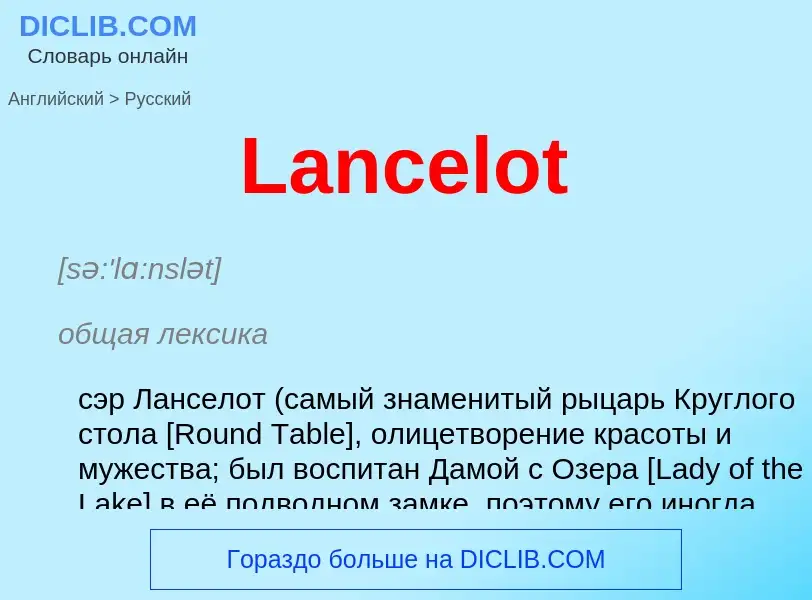Translation and analysis of words by ChatGPT artificial intelligence
On this page you can get a detailed analysis of a word or phrase, produced by the best artificial intelligence technology to date:
- how the word is used
- frequency of use
- it is used more often in oral or written speech
- word translation options
- usage examples (several phrases with translation)
- etymology
Lancelot - translation to English
[sə:'lɑ:nslət]
общая лексика
сэр Ланселот (самый знаменитый рыцарь Круглого стола [Round Table], олицетворение красоты и мужества; был воспитан Дамой с Озера [Lady of the Lake] в её подводном замке, поэтому его иногда называют Ланселотом с Озера [Lancelot of the Lake])
синоним
существительное
общая лексика
Ланс(е)лот
Ланцелот
Ланселот (мужское имя)
олицетворение красоты и мужества
['lɑ:n|slət'lɔ:n{slət}-]
синоним
Wikipedia

Lancelot du Lac (French for Lancelot of the Lake), also written as Launcelot and other variants (such as early German Lanzelet, early French Lanselos, early Welsh Lanslod Lak, Italian Lancillotto, Spanish Lanzarote del Lago, and Welsh Lawnslot y Llyn), is a character in some versions of Arthurian legend where he is typically depicted as King Arthur's close companion and one of the greatest Knights of the Round Table. In the French-inspired Arthurian chivalric romance tradition, Lancelot is an orphaned son of King Ban of the lost kingdom of Benoic, raised in a fairy realm by the Lady of the Lake. A hero of many battles, quests and tournaments, and famed as a nearly unrivalled swordsman and jouster, Lancelot becomes the lord of the castle Joyous Gard and personal champion of Arthur's wife, Queen Guinevere, despite suffering from frequent and sometimes prolonged fits of madness. But when his adulterous affair with Guinevere is discovered, it causes a civil war that, once exploited by Mordred, brings an end to Arthur's kingdom.
Lancelot's first datable appearance as main character is found in Chrétien de Troyes' 12th-century French poem Lancelot, the Knight of the Cart, which already centered around his courtly love for Guinevere. However, another early Lancelot poem, Lanzelet, a German translation of an unknown French book, did not feature such a motif and the connections between the both texts and their possible common source are uncertain. Later, his character and story was expanded upon Chrétien's tale in the other works of Arthurian romance, especially through the vast Lancelot-Grail prose cycle that presented the now-familiar version of his legend following its abridged retelling in Le Morte d'Arthur. There, Lancelot's and Lady Elaine's son Galahad, devoid of his father's flaws of character, becomes the perfect knight that succeeds in completing the greatest of all quests, achieving the Holy Grail when Lancelot himself fails due to his sins. Both loyal and treasonous, Lancelot has remained a popular character for centuries and is often being variably reimagined by modern authors.




.jpg?width=200)

![James Archer]]'s ''Sir Launcelot and Queen Guinevere'' (1864) James Archer]]'s ''Sir Launcelot and Queen Guinevere'' (1864)](https://commons.wikimedia.org/wiki/Special:FilePath/SIR LAUNCELOT AND QUEEN GUINEVERE).jpg?width=200)

![[[Sidney Paget]]'s painting ''Lancillotto ed Elena'' depicting Elaine of Astolat [[Sidney Paget]]'s painting ''Lancillotto ed Elena'' depicting Elaine of Astolat](https://commons.wikimedia.org/wiki/Special:FilePath/Sidney Paget - Lancillotto ed Elena.jpg?width=200)

![Lancelot's rescue of Guinevere from the stake in [[Henry Justice Ford]]'s illustration for Andrew Lang's ''Tales of the Round Table'' (1908) Lancelot's rescue of Guinevere from the stake in [[Henry Justice Ford]]'s illustration for Andrew Lang's ''Tales of the Round Table'' (1908)](https://commons.wikimedia.org/wiki/Special:FilePath/Tales of the Round table; based on the tales in the Book of romance (1908) (14580312508).jpg?width=200)
![An illustration for ''Tales of the Round Table'', abridged from ''Le Morte d'Arthur'' by [[Andrew Lang]] (1908): "Sir Lancelot did not stop, and the archers shot his horse with many arrows, but he jumped from its back and ran past them deeper into the wood." An illustration for ''Tales of the Round Table'', abridged from ''Le Morte d'Arthur'' by [[Andrew Lang]] (1908): "Sir Lancelot did not stop, and the archers shot his horse with many arrows, but he jumped from its back and ran past them deeper into the wood."](https://commons.wikimedia.org/wiki/Special:FilePath/Tales of the Round table; based on the tales in the Book of romance (1908) (14580337558).jpg?width=200)
![A 1958 advertisment for the television series ''[[The Adventures of Sir Lancelot]]'' A 1958 advertisment for the television series ''[[The Adventures of Sir Lancelot]]''](https://commons.wikimedia.org/wiki/Special:FilePath/The Adventures of Sir Lancelot - Broadcasting, October 20, 1958.jpg?width=200)

 (14566092039).jpg?width=200)
![knight of the badly-cut coat]]." (''[[Tristan en prose]]'' c. 1479–1480) knight of the badly-cut coat]]." (''[[Tristan en prose]]'' c. 1479–1480)](https://commons.wikimedia.org/wiki/Special:FilePath/IRHT 305652 2 P.jpg?width=200)



!["[Lancelot] ever ran wild wood from place to place" "[Lancelot] ever ran wild wood from place to place"](https://commons.wikimedia.org/wiki/Special:FilePath/Boys King Arthur - N. C. Wyeth - p52.jpg?width=200)

